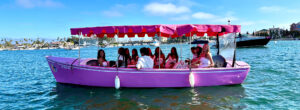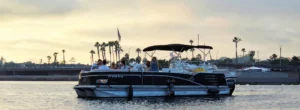Introduction
Fishing from a pontoon boat combines comfort with capability, offering a unique approach to a favorite pastime. Unlike the cramped quarters of traditional fishing vessels, pontoons provide spacious platforms ideal for groups, families, or those who appreciate a bit more elbow room while they cast their lines. This article delves into the essentials of pontoon fishing, covering everything from selecting the right boat and gear to identifying the best fishing spots.
Pontoon boats are particularly favored for their stability and versatility, making them suitable for both novice and experienced anglers. They are equipped to handle various water conditions and can be easily customized to enhance the fishing experience. With the right setup, pontoons can transform into a fisherman’s dream, allowing for a variety of fishing techniques in comfort and style.
Whether you’re planning a casual fishing trip or a serious angling expedition, understanding how to maximize your pontoon for fishing can significantly enhance your chances of a successful catch. Let’s explore how you can optimize your pontoon fishing experience from gear to techniques and beyond.
Choosing the Right Pontoon Boat for Fishing
Not all pontoons are created equal, especially when it comes to fishing. When selecting a pontoon boat for fishing, look for features that will support your angling activities. Essential features include rod holders, a live well for keeping bait and catches alive, a fish finder, and ample storage for tackle and tools. Some fishing pontoons also come with built-in tackle boxes, elevated fishing chairs, and even customized casting platforms.
Size and motor power are also important considerations. A larger deck provides more space for casting and can accommodate more people without feeling crowded. However, the size should also be appropriate for the waters you plan to fish in. As for the motor, look for one that is powerful enough to navigate current and wind but quiet enough not to disturb the fish.
Lastly, ensure that the pontoon boat offers comfortable seating and protection from the elements, such as a canopy or Bimini top. Comfort is crucial during long hours on the water, and shielding from sun and rain can make the experience more enjoyable and safer for everyone aboard.
Essential Fishing Gear for Pontoon Anglers
The right gear can make or break your fishing trip. Basic fishing gear for pontoon anglers includes a variety of rods and reels to suit different types of fish and water conditions. For versatility, carry both light and heavy rods, and consider the types of bait that are most effective for the local fish species. Line strength should also be appropriate for the target fish size and the environment.
In addition to the basics, specialized equipment like a fish finder can dramatically improve your chances of locating fish. A good fish finder will help you identify the depth and structure of the water body, which are critical for successful fishing. Other helpful gear includes a GPS for navigation, especially in unfamiliar waters, and a net for safely landing your catch.
Don’t forget personal items such as waterproof clothing, sunscreen, and a first aid kit. Safety and comfort are paramount, so prepare for changes in weather and potential emergencies.
Setting Up Your Pontoon for Fishing
Properly setting up your pontoon boat can significantly enhance your fishing efficiency and success. Start by ensuring that all your fishing gear is easily accessible yet out of the way to prevent accidents or interference with movement. Organize your rods, tackle, and bait near the fishing areas of the pontoon to avoid having to move around excessively during fishing.
Consider installing additional features if they are not already included, such as extra rod holders for trolling or vertical jigging, and additional storage solutions for gear and personal items. Customizations like swivel seats can also make a big difference, allowing you to stay in a comfortable position as you cast in different directions.
Ensure that the layout of your pontoon remains balanced to avoid capsizing or undue tilting, especially when fighting larger fish. The arrangement should allow everyone on board to move freely without disrupting the water around the boat, which could scare away fish.
Best Fishing Techniques for Pontoon Boats
Pontoon boats are well-suited for a variety of fishing techniques, but some methods are particularly effective from these types of vessels. Trolling is one of the most popular techniques, as it allows you to cover a large area and attract fish with moving bait. Pontoons can maintain a steady speed and course, making them ideal for this method.
Still fishing is another technique that works well on pontoons. Since pontoons offer a stable platform, you can anchor in a promising spot and use live bait or lures to attract fish. This method is particularly effective in lakes and rivers with a lot of structure, where fish may hide.
Fly fishing can also be adapted for pontoons, although it typically requires more space due to the nature of the casting. If your pontoon has a large open deck area, you can practice fly casting without the risk of snagging your line on the boat’s fixtures or other passengers.
Top Fishing Spots for Pontoons
Choosing the right spot is crucial for successful pontoon fishing. Look for areas with abundant aquatic life and natural structures such as weed beds, submerged trees, and drop-offs, where fish are likely to congregate. Lakes, slow-moving rivers, and coastal backwaters are ideal for pontoons due to their calm waters and rich ecosystems.
Research local fishing reports and maps to identify the most productive fishing spots in your area. Online forums and local angling clubs can also provide valuable insights into where the fish are biting and which spots are accessible by pontoon. Be mindful of local regulations and ensure you have the necessary permits and licenses for the areas you plan to fish.
Environmental factors such as water temperature, time of year, and weather conditions can also affect fish behavior and distribution. Keep a record of your outings and the conditions to learn what works best in your chosen fishing spots.
Navigating and Anchoring Your Pontoon for Optimal Fishing
Navigating a pontoon boat for fishing requires knowledge of both the vessel and the fishing environment. Pontoons are larger and less maneuverable than typical fishing boats, so plan your route to avoid narrow or shallow areas where you could get stuck or damage the boat.
When it comes to anchoring, use a system that’s robust enough to hold the pontoon steady even in currents or windy conditions. A reliable anchoring system prevents the boat from drifting and ensures that your fishing spot remains consistent, especially important when you’re targeting specific structures where fish are known to hide.
Additionally, consider the depth and the type of bottom (mud, sand, rock) when selecting your anchor type. Different conditions require different anchors to hold effectively. Always have more than one anchor onboard to secure the pontoon from different angles if needed, which can be particularly useful in changing wind or current conditions.
Handling and Safety Tips While Fishing on a Pontoon
Safety should always be a top priority when fishing on a pontoon. Ensure that all passengers are aware of the boat’s safety features and understand basic safety practices such as wearing life vests and knowing how to use the onboard safety equipment.
Keep pathways clear of gear and obstructions to prevent accidents. Pontoons are stable, but it’s important to maintain balance and avoid abrupt movements that could destabilize the boat, especially when reeling in a big catch.
Be prepared for emergencies by having a well-stocked first aid kit, a method of communication like a cell phone or marine radio, and an emergency plan that all passengers are familiar with. Regular maintenance checks on the boat’s safety and navigation systems are also essential to ensure they function properly when needed.
Keeping Your Catch Fresh
Proper handling of your catch is important not only for food safety but also for quality. Use a live well or an insulated cooler with ice to keep your fish fresh throughout the day. If you plan to release your catch, handle the fish as little as possible and use tools like pliers to remove hooks gently.
If your pontoon is equipped with a live well, make sure it has adequate aeration and water circulation to keep the fish alive and healthy. This is particularly important in warmer weather when oxygen levels in the water can drop.
For those keeping their catch, consider cleaning the fish on the boat if regulations and facilities permit. This reduces mess and simplifies the process once you return to shore. Be sure to dispose of any waste properly to avoid attracting pests and maintain cleanliness on your pontoon.
Conclusion
Fishing from a pontoon offers a blend of comfort and efficiency, making it an excellent choice for anglers of all levels. With the right pontoon setup, appropriate gear, and knowledge of the local fishing environment, anglators can enjoy productive and enjoyable fishing trips. Embrace the stability, space, and versatility of pontoon fishing and you might find it’s your preferred way to cast a line.
Whether you’re after a quiet day of relaxation or an intense angling adventure, a pontoon provides the perfect platform. Remember to respect the waterways and practice sustainable fishing to ensure that these wonderful resources can be enjoyed by future generations. Happy fishing!
Excited for an adventure with us or have a question? Call us at: (949) 675-8433 Book Your Ride with us: Click here to Book


